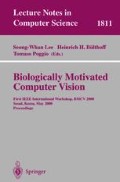Abstract
Originally the Interactive Activation Model(IAM) was developed to expalin Word Superiority Effect(WSE) in the English words. It is known that there is a similar phenomena in Korean characters. In other words people perceive a grapheme better when it is presented as a component of a character than when it is presented alone. We modified the orginal IAM to explain the WSE for Korean characters. However it is also reported that the degree of WSE for Korean characters varies depending on the type of the character. Especially a components was reported to be hard to perceive even though it is in a context. It was supposed that this special phenomenon exists for WSE of Korean characters because Korean character is a two-dimensional composition of components(graphemes). And we could explain this phenomenon by introducing weights for the input stimulus which are calculated by taking into account the two-dimensional shape of the character.
Access this chapter
Tax calculation will be finalised at checkout
Purchases are for personal use only
Preview
Unable to display preview. Download preview PDF.
References
Robert J. Sternberg, Cognitive Psychology, Harcourt Brace & company, 1996.
Reicher G. M., Perceptual recognition as a function of meaningfulness of stimulus material, Journal of Experimental Psychology, 1969, 274–280.
McClelland J. L., Rumelhart D. E., An Interactive Activation Model of Context Effects in Letter Perception: Part 1. An Account of Basic Findings, Psychological Review, volume 88, number 5, september, 1981, 375–407.
J. K. Kim, J. O. Kim, Grapheme cognition in Korean character context, Ph. D. Thesis (in Korean), Seoul National University, 1994.
Peter T. Daniels, William Bright, The World’s Writing Systems, Oxford University Press, 1996, 218–227.
Baron J., Thurston I., An analysis of the word-superiority effect, Cognitive Psychology, 1973, 4, 207–228.
Kathryn T. Spoehr, Stephen W. Lehmkuhle, Visual Information Processing, W. H. Freeman and Company, 1982, 133–161.
Florin Coulman, TheBlackwell Encyclopedia of Writing Systems, Blackwell, Oxford, 273–277.
Geoffrey Sampson, Writing Systems, Hutchinson, London, 1985, 120–144.
M. S. Kim, C. S. Jung, Cognitive of grapheme and character by grapheme composition form in Korean, Cognitive Science, Korean Cognitive Science Association, 1989, 1, 27–75.
Author information
Authors and Affiliations
Editor information
Editors and Affiliations
Rights and permissions
Copyright information
© 2000 Springer-Verlag Berlin Heidelberg
About this paper
Cite this paper
Park, C.S., Bang, S.Y. (2000). Modeling Character Superiority Effect in Korean Characters by Using IAM. In: Lee, SW., Bülthoff, H.H., Poggio, T. (eds) Biologically Motivated Computer Vision. BMCV 2000. Lecture Notes in Computer Science, vol 1811. Springer, Berlin, Heidelberg. https://doi.org/10.1007/3-540-45482-9_31
Download citation
DOI: https://doi.org/10.1007/3-540-45482-9_31
Published:
Publisher Name: Springer, Berlin, Heidelberg
Print ISBN: 978-3-540-67560-0
Online ISBN: 978-3-540-45482-3
eBook Packages: Springer Book Archive

